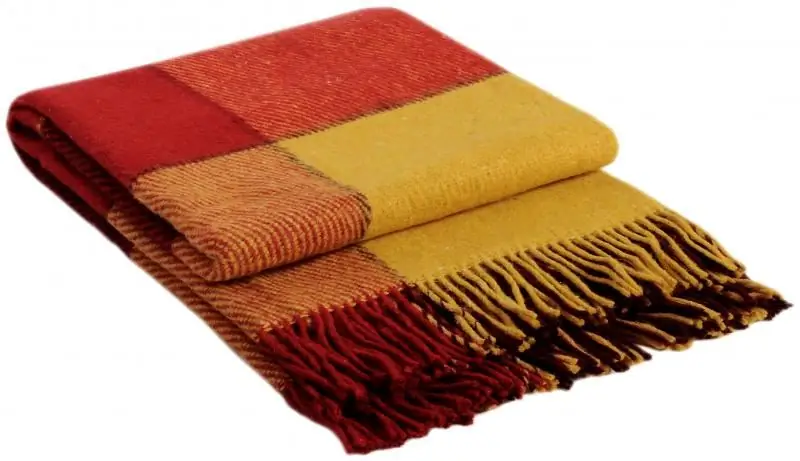
Table of contents:
- Author Bailey Albertson [email protected].
- Public 2023-12-17 12:53.
- Last modified 2025-06-01 07:32.
Declaring war on blood stains on clothes and linen

Everyone encounters stains on clothes. And you probably know that traces of blood are considered the most difficult to remove. However, in life nothing is impossible, so you can cope with this trouble at home. You just need to apply the appropriate tactics of struggle: everything is like on the battlefield. So, the strategy of a victorious battle with blood stains.
Content
- 1 How to remove fresh tracks?
-
2 Effective ways to remove stubborn blood stains
2.1 How to get rid of old traces of blood by machine washing?
-
3 How to properly treat stains on different fabrics of clothing?
-
3.1 White cotton
3.1.1 Video: How to remove a blood stain with hydrogen peroxide?
- 3.2 Silk
- 3.3 Wool
- 3.4 Suede
- 3.5 Leather
- 3.6 Denim, jeans
- 3.7 Down jackets
-
How to remove fresh traces?

The best way to get rid of the stain is to wipe the affected area as quickly as possible.
Why are blood stains so difficult to wash? It's all about chemistry. The blood contains a protein that, upon reaction with air or high temperature, "seals" the stain into the tissue, turning into a strong dye. So the sooner you find a mark on clothes or underwear, the faster you need to act, that is, wash. For all fabrics (except suede), the proven method is suitable:
- We supply the stain under cold water.
- We wash with laundry soap (brown or white - no difference).
- We wash the rest of the trace with water.
If necessary, we wash the item as usual. If there is no such need, then simply dry. In the case when a significant part of the fabric is stained, it makes sense to soak it in cold water for several hours, for example, overnight. Alternatively, change the water several times every 30-40 minutes, and then wash in warm water with powder.
Effective ways to remove stubborn blood stains

The most reliable remedies for removing traces of blood are in every home.
If the trail has eaten into the fabric, then simple washing is no longer enough. We need heavy artillery. In this matter, several proven means will successfully play its role. They can be used on colored cotton or synthetic fabrics.
- Salt (dissolve 1 tablespoon of table salt in 1 liter of water). Fill the stain with the resulting solution, preferably overnight, and then wash it with laundry soap and wash it with powder.
- Soda (for 100 g of soda 2 l of water). We soak the product for 30 minutes, wash or rinse.
- Dishwashing gel. Pour on the stain, leave for 2-3 hours, wash with powder.
- Glycerol. We moisten a cotton pad with it, wipe the stain, and then wash it with the addition of powder.
- Lemon juice with salt (juice of ½ lemon and 2 tablespoons of salt). Apply to the stain, rinse with water.
How to get rid of old traces of blood by machine washing?

If you prefer to wash in a machine, then remember that the water must be cold.
Some housewives are used to solving all problems with stains by washing in a machine. For blood stains, this method is quite applicable, but only if certain points are observed:
- wash only in cold water;
- add stain remover to the powder.
As for the latter, it can be a special tool (for example, "Vanish", suitable for the color of the thing) or a mixture of table salt and ammonia in a ratio of 1 tbsp. l. 20 ml (for light cotton items).
How to properly treat stains on different fabrics of clothing?

You should not throw away a thing that could not be washed "hot on the trail" - there are several ways to do this
The described methods can be considered more or less universal, but for some things there are special methods of dealing with traces of blood.
White cotton

The trace remaining after treatment must be washed off with running water.
- The most reliable method for removing stains is "Whiteness". Fill in the stain, wait for dissolution and erase as usual.
- An alternative to White is Domestos. Add 1 cap of the product to a bowl of cold water, put the item, intensively wash the stain and, after 2-3 hours of soaking, wash it as usual.
- White vinegar. Fill the stain, wait 30 minutes, erase.
- Soda ash (50 g per 1 liter of cold water). Soak the thing in solution for 10 hours, wash. If there are yellow stains, remove them with bleach.
- Shampoo. We soak the fabric in cold water with the addition of shampoo for 2 hours, and then wash.
- Bura. We mix sodium tetraborate (borax) with ammonia. We dilute the mixture with water in a 1: 2 ratio. We soak the item for 4-5 hours, wash it.
- Hydrogen peroxide. Pour blood on the trail, rinse off after 10 minutes.
Video: How to remove a blood stain with hydrogen peroxide?
Silk

It is better to wash silk clothes after removing the stain completely, otherwise streaks may remain.
This material is the most difficult to clean, as the risk of ruining the fabric is too great. Therefore, experts recommend, in addition to regular washing, only one more method - using potato starch.
- Fill the starch with cold water until mushy.
- We process the blood trail.
- After drying, carefully brush off the mass with a toothbrush, if necessary, wash the thing.
Wool

When removing stains from woolen items, it is imperative to test the product on an inconspicuous area of the product
Natural fibers are more difficult to wash off, as the blood eats deep into the thread. And nevertheless, you should not rush to throw away the thing - you can still "fight" with the stain. We choose ammonia as a weapon.
- We breed 1 tbsp. l. ammonia in 1 liter. cold water.
- Soak the stain.
- We wash or wash with warm water.
Another option is aspirin.
- Fill the tablet with 2 tbsp. l. water.
- Apply the mixture to the stain.
- When the stain starts to fade, rinse it with cold water.
Suede leather

When removing stains from suede, remember that this material cannot be heavily wetted
Regardless of the age of the stain, first we remove the blood from the pile using fine sandpaper or a regular eraser. And then
- Dissolve a little baby soap in water.
- Apply with a sponge to the stain, moisten the napkin with cold water.
- Apply to the stain and let the skin soften slightly.
- Process again with soapy water.
- We repeat the procedure until the trace disappears completely.
For light suede, you can use ammonia or hydrogen peroxide
Leather

First, you need to try to remove the blood stain on the leather thing with soapy water - it is the least dangerous for the material
Handling leather items requires extreme care. If there are blood stains on the product, there are two ways to remove them:
- soapy water (wipe the stain);
- hydrogen peroxide (this option for processing pollution is possible only after the effect of the substance has been tested on an inconspicuous area of the thing).
Denim, jeans

Removing stains from denim takes patience and time
Jeans is the most difficult material to remove stains. This is due to the fact that the fibers of the fabric are very loose, and any contamination easily penetrates into them. And yet you can cope with them. In addition to the above methods with dishwashing gel and soda solution, you can use a slightly modified version with shampoo.
- Fill the stain with table salt.
- Fill with shampoo.
- Rub in until foam forms.
- Rinse in cool water.
There is also an option with a meat tenderizer.
- Rub into the fabric and leave for 30 minutes.
- We wash jeans in warm water with washing powder.
Down jackets

You can use a soft brush to remove residues of the product that removes traces of blood from the down jacket.
A separate topic is the removal of stains from outerwear, especially from down jackets, which are not recommended to be washed often (or even not at all to be done at home). How to get rid of a trace of blood? You can use the method with ammonia, soda or peroxide if the thing is white. But for colored ones, methods with starch, glycerin and soap are suitable. But before deciding on any action, assess the scale of the problem: if the stain is large and located in a conspicuous place, then it is better to immediately contact a dry cleaner. Otherwise, experts may simply not take up cleaning the thing that you were trying to bring back to life at home.
Blood stains, especially old ones, are not easy to remove. And the success of the enterprise depends not only on the freshness of the trace, but also on which product you use. Despite the abundance of folk methods of getting rid of this kind of contamination, it is still better to use special stain removers for this or that type of fabric, so as not to inadvertently ruin the thing. And do not forget that the faster the "battle" begins, the more chances of victory.
Recommended:
How To Wash Sneakers In The Washing Machine And By Hand, Including White, The Nuances Of Washing + Photos And Videos

Sneakers are shoes that are comfortable and easy to wear for a walk, nature and even a date. If they get dirty, it doesn't matter. You can always wash them
How To Get Rid Of An Unpleasant Smell In A Washing Machine: We Remove Odors Of Mold, Gasoline And The Like + Photos And Videos

Why unpleasant odors appear in the washing machine and how to get rid of them. In what cases can you fix the problem without calling the wizard
How And What To Wash The Blood From The Sofa, Mattress, Upholstered Furniture And Other Items In The Apartment + Photos And Videos

Blood stains can ruin various types of surfaces. We will tell you how to remove them from furniture, wallpaper, ceiling, as well as how to wash them off shoes with improvised means
How To Wash Shoes In A Washing Machine Or Manually, Is It Possible To Do It, How To Do It Correctly + Photos And Videos

How to properly wash shoes by hand and in a washing machine. Features of shoe care from different materials: tips, recipes, recommendations
How To Wash A Blanket At Home, Is It Possible To Use A Washing Machine, Which Mode To Choose + Photos And Videos

What materials are blankets made of? Natural and artificial fabrics. How to wash them in the washing machine or by hand. Proper storage
